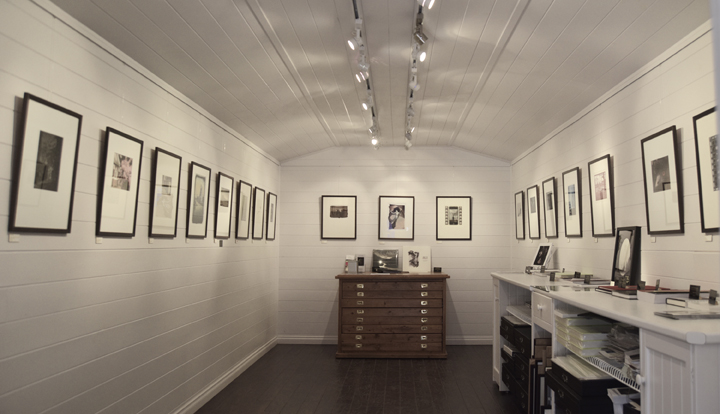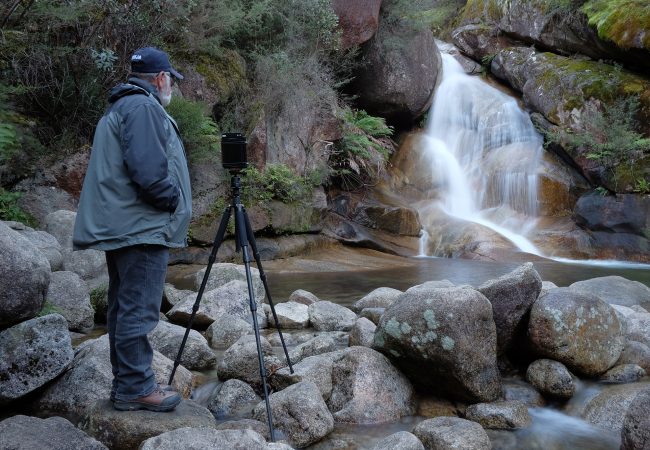This review is the third looking at the pinhole cameras…
The Print Exposed 2017

6th March to 30th April at Gold Street Studios, Australia
Entering the long slim white-walled gallery, a visitor will see small photos presented elegantly in dark edged frames. A cursory glance at The Print Exposed 2017 exhibition at Gold Street Studios will show many analogue photography and development techniques mastered once again. But for what end?
George Orwell argued that ‘In our age there is no such thing as ‘keeping out of politics’. All issues are political issues…’ The Print Exposed 2017 presents a political statement made in these times of closing art schools and a valuing of products of culture only in monetary terms. This small exhibition of carefully tended photographs presents a careful viewer with an alternative political view where the hand made and considered image are valued.
The stand out political image is Craig Tuffin’s Black Fella White Fella Brown Fella, concerned with a reconciliation narrative. Tuffin presents the viewer with an image of an indigenous man in headdress and ceremonial paint, dressed in a modern suit. The subject sits squarely in the frame and stares directly at the viewer confronting the audience assumption that it is they who are looking at the man in the frame; perhaps he is examining us? This carefully crafted composition challenges the audience to think about cultural values and difference verses sameness. Tuffin honours his subject in a finely produced daguerreotype, with the ultimate mirror finish. At the concurrent symposium, Tuffin wouldn’t share his method of polishing keeping it as a trade secret, (which he is entitled to do). But what he doesn’t realise that it is not the polishing that makes the image, but his personal quest to see some justice done between Indigenous and European Australia. The daguerreotype mirror reflects the politics of the photographer as much as it is about the image and the viewer. Tuffin’s work won best in show.

Chris Reid makes his political comment through a silver gelatine image Fauxtography and the photograph in which he discusses the conflicting values of digital and handmade images. Reid values the considered image over the “iphony” multiple images where image creation uses the attrition method (if you take enough images, one will be good). He argues we need to look to the days of film for a re-visioning of how we take photographs.
Elizabeth Opalenik, guest presenter at the concurrent symposium, presents her handmade image using mordancage, an intense method of floating and rearranging the sliver gelatine ‘veil’ whilst keeping an image. Changer la femme v4 2016 presents an unclothed female model reclothed in the silver gelatine ‘veils’. Technically brilliant, centrally composed, this gorgeous image refuses the conventions of the picture frame with billowing veils migrating outside the borders. It is an image that could be construed as feminist; it asks me to contemplate the difference between the male gaze and the female gaze. And it is the only image that speaks of the body in this exhibition.
Many photographs engage the landscape genre making a wider comment on the importance of nature in our culture. Mike McCaw O’Brians Crossing (pinhole, silver gelatine) makes me smell the river and with Jennifer Page’s Breaking Wave (Copperplate photogravure) I have the expectation of seasalt spray. I am caught with an uneasy feeling with Peter McDonald’s St Edmunds Anglican Church Gunning (Pinhole Silver Gelatine), with the deep tree shadows and firmly shut church door. Stuart Clook won the Mike Ware Award for his logged landscape in low light, Marching Trees (Gum over platinum). The judge commented that the image appeared to glow and it was a good use of glitter to achieve the effect.
Some images in this exhibition challenge how places and objects are seen thought the use of abstraction. Tim Rudman’s Montana #7 (Silver Gelatine Thiorea and Selenium toned) is my pick. This photo almost transitions into drawing, the spare line of the fence in the snow is representational but abstraction at the same time. I like the confident composition and the zen-like feeling of space. It is a picture that breathes.
Lynette Zeeng, Kim Sinclair and Renata Buziak are all masters of the spare image, where the audience is expected to do some work in bringing one’s own thoughts to make an interpretation.
I can’t finish this review without talking about Csaba Farkas who contributed three beautiful images to the exhibition. These works I found compositionally exceptional as they based on the golden mean. Farkas shows how photography is intimately linked to other art disciplines through the use of a compositional system designed by Leon Battista Alberti (1404 – 1472). Who knew that the influence of the Italian renaissance would be on show in a small gallery in rural 21st century Australia?

This review has left out many worthy photos that speak softly of their politics. The Print Exposed is an exhibition worthy of ‘slow’ viewing. Time spent with each print will expose the brilliance that each artist has brought to their hand made print and a considered viewing will reveal the interesting story of the politics of behind each work.
Penny Dunstan
Next Post: Review: Foma Retropan 320 Soft 4×5 Film
Previous Post: 8×10 developing tank by Stearman Press



